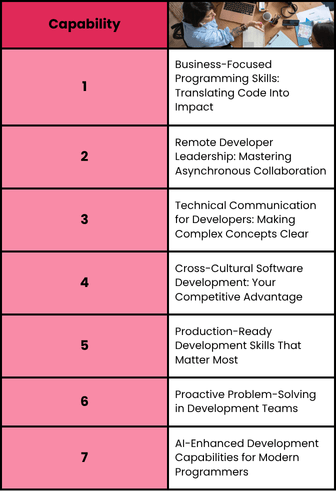
Security-First Culture in Nearshore Teams: Scale Securely
Transform your security team from bottleneck to enabler with security-first nearshore development. Avoid vulnerabilities and scale securely. Learn more.
Read More

Your computer science degree taught you to code. But US companies aren't hiring coders—they're hiring problem solvers who happen to code.
Picture this: You're a LATAM developer staring at rejection email #47. Your algorithms are flawless. Your academic projects? Pristine. Yet that dream US remote role keeps slipping away.
Here's why you're asking the wrong question.
It's not "Am I good enough?"
It's "Am I speaking their language?"
While you've been perfecting syntax, US companies rewrote the playbook on what "production-ready" actually means.
They don't want code that compiles. They want developers who can navigate the beautiful chaos of real business—where deadlines shift like sand, requirements evolve hourly, and success gets measured in user smiles, not test coverage.
What You'll Walk Away With
By the end of this piece, you'll understand why technical brilliance alone won't cut it in 2025. More importantly, you'll have a battle-tested roadmap to transform your academic foundation into the industry-ready skills that have US employers hitting refresh on job boards at 3 AM.
You'll discover the seven critical capabilities that separate hired developers from overlooked ones—and how to build each one systematically.
Ready? Let's decode the matrix.
The numbers don't lie—they scream.
According to the World Economic Forum's Future of Jobs Report 2025, 44% of workers' core skills will be disrupted by 2027. AI and big data understanding? Expected in 90% of job postings across industries.
But here's the plot twist the reports miss: for LATAM developers gunning for US positions, this disruption is your golden ticket.
While North American developers scramble to adapt, you're already fluent in uncertainty. Resource constraints? Tuesday. Rapid adaptation? Your Tuesday afternoon.
The Disruption Advantage: The most successful professionals will seamlessly blend technological prowess with distinctly human superpowers.
Reality Check: If you had 60 seconds to convince a US hiring manager that you can solve problems they don't even know they have yet, what would you say?

Forget everything you learned about "clean code" for exactly 30 seconds.
In production environments, the cleanest code is the code that solves the right problem at the right time with the right trade-offs. US companies are drowning—literally drowning—in developers who build gorgeous solutions to problems that don't matter.
What they desperately need—and what 73% of employers prioritize by 2025—is creative thinking weaponized for business contexts.
The Translation Challenge:
Your academic projects obsessed over algorithmic elegance. Production projects obsess over business impact. The developer who can explain why they chose a "messy" but scalable solution over an "elegant" but inflexible one? That developer wins the role. Every single time.
This means understanding not just how to implement a feature, but why it exists, who it serves, and how it connects to revenue, user experience, or operational efficiency.
Your Next Move:
Start reframing every coding decision through business impact.
Before: "I used a hash map for O(1) lookup."
After: "I chose this data structure because it keeps our API response times under 200ms even when our user base grows 10x, which directly supports our customer retention goals."
The Mirror Test: Can you articulate the business cost of every technical decision you make? If not, you're still thinking like a student, not a professional.
Here's something your professors never mentioned: in remote US companies, the ability to lead without being physically present is worth more than being the strongest coder in the room.
Your timezone isn't a disadvantage—it's your competitive edge.
Understanding the 8 emerging trends for LATAM remote developer success can help you weaponize this advantage effectively.
The Timezone Superpower:
While US developers sleep, you can be the person who unblocks the team, reviews critical pull requests, and keeps projects breathing. But only if you know how to lead asynchronously.
This isn't about sending more Slack messages. It's about creating clarity where confusion exists, making decisions when others hesitate, and building systems that work whether you're online or not.
By 2025, companies will be desperately seeking developers who can drive projects forward across time zones through documentation, strategic communication, and decision-making.
Your Development Plan:
Start treating every piece of code documentation as leadership. Your commit messages should tell a story. Your pull requests should teach something. Your project updates should move the team forward, not just report status.
The 48-Hour Test: If you disappeared for 48 hours, would your current project move forward, slow down, or completely stall? Your answer reveals your leadership maturity.
US companies face a universal problem: they're building increasingly complex products for people who think "API" is a type of beer.
They need developers who can translate technical concepts into business language, user benefits, and stakeholder confidence.
The Communication Revolution:
This skill is exploding in demand—business communication rose 19% globally in 2024 according to Udemy's Global Workplace Learning Index.
But this goes beyond writing documentation. It's about becoming the person who can explain why a seemingly simple feature actually requires three weeks of backend work, or why that "quick fix" could break everything six months from now.
Your Multilingual Advantage:
Your multilingual background gives you a massive edge here. If you can explain complex concepts across languages and cultures, you can certainly explain them across technical and business domains.
The Skill Builder:
Practice the "grandmother test"—if you can't explain your current project to your grandmother in a way that makes her understand why it matters, you can't explain it to a stakeholder either.
The Conviction Question: When was the last time you convinced someone to invest time or money in a technical solution by explaining its value, not its features?
While US developers debate whether to comment their code more, you're navigating entirely different programming cultures, languages, and business contexts.
This isn't just a soft skill—it's becoming a hard requirement.
The Cultural Bridge Advantage:
Companies are realizing that technical competence without cultural adaptability creates expensive communication breakdowns. They need developers who can work with distributed teams, understand different business contexts, and facilitate understanding between people who think differently.
Your bilingual, bicultural nature isn't something you mention in passing—it's your primary value proposition. You're not just a developer who happens to be from Latin America; you're a cultural bridge who can also code.
Your Strategic Development:
Start documenting your cross-cultural problem-solving approaches. How do you handle disagreements across cultures? How do you explain technical concepts to non-technical stakeholders from different backgrounds?
These aren't soft skills—they're business-critical capabilities.
The Experience Audit: How many times have you prevented a miscommunication or solved a problem specifically because of your cultural perspective? If you can't count at least five examples, you're undervaluing your own experience.
Here's the remote work secret nobody tells you: invisible work doesn't exist.
US companies are moving toward radical transparency about work processes, not because they don't trust you, but because they need to make sure everyone's efforts align with business goals.
The Visibility Framework:
This isn't about surveillance—it's about making your problem-solving approach visible and valuable to your team. The developers who get promoted are the ones whose thinking process is as visible as their output.
Your Git commits should tell a story. Your pull requests should teach something. Your debugging process should be documented and shared. Make your iterative improvement process visible, not just your final results.
Your Implementation Strategy:
Start thinking of every interaction with your codebase as content creation. Your future teammates should be able to understand not just what you built, but how you thought through the problem and why you made specific choices.
The Learning Test: If a new team member looked at your recent commits and pull requests, could they learn something valuable about problem-solving, not just about your specific solution?
Academic projects have clear requirements and known solutions. Production systems have evolving requirements and unknown problems that haven't surfaced yet.
The most valuable developers spot issues before they become crises.
Your Resource Constraints Advantage:
Your experience working with resource constraints and diverse challenges gives you a unique ability to spot inefficiencies and risks that others might miss. But you need to frame this as strategic value, not just helpful observation.
This means regularly auditing your team's processes, identifying potential technical debt, proposing performance improvements, and suggesting preventive measures.
Don't just solve assigned problems—solve problems that haven't been assigned yet. This proactive mindset is exactly what makes LATAM software developers special in the global market.
Your Development Process:
Develop a systematic approach to identifying potential issues. Create personal checklists for code review that go beyond functionality to consider scalability, maintainability, and business risk.
The Ownership Question: What problem did you solve this month that nobody asked you to solve? If the answer is "none," you're still thinking like an employee, not like an owner.
Reality check time: AI isn't replacing developers, but developers who effectively collaborate with AI are replacing those who don't.
The Market Reality:
The U.S. Bureau of Labor Statistics projects that software developer employment will grow 17% from 2022 to 2030—much faster than average. Meanwhile, the global AI software market is projected to reach $126 billion by 2025.
But this isn't about learning to use ChatGPT for coding. It's about understanding how to use AI as a thinking partner, not a replacement for thinking.
Your Multilingual Edge:
The most valuable developers will leverage AI to handle routine tasks while focusing their human intelligence on creative problem-solving, business strategy, and interpersonal collaboration.
Your multilingual abilities give you an edge here—you can potentially prompt engineer in multiple languages and understand AI outputs across different cultural contexts.
Your Training Protocol:
Start treating AI as a junior developer on your team. Give it well-structured problems, review its outputs critically, and learn to identify when human insight is irreplaceable.
For deeper insights into AI development and career opportunities, explore what an AI developer actually does in today's market.
The Strategy Test: Can you identify three specific ways AI could make you a more valuable developer without making you more replaceable? If not, you're thinking about AI wrong.
Looking toward 2030, the most successful LATAM developers won't be the ones with the most technical skills—they'll be the ones who became indispensable strategic partners to US businesses.
According to McKinsey's research on the future of work, there's a critical need for talents with better technological, cognitive, and social skills combined.
The Bridge Professional Era:
The market is shifting toward what I call "Bridge Professionals"—people who can connect different worlds: technical and business, local and global, human and artificial intelligence.
Your natural advantages position you perfectly for this evolution, but only if you start building these capabilities now.
They'll be the cultural code translators who can navigate technical complexity, business strategy, and human dynamics with equal skill.
If you're serious about advancing your career and mastering these skills systematically, our comprehensive developer career advancement guide provides additional strategies for professional growth in competitive markets.
Time for brutal honesty. No sugarcoating. No participation trophies.
The Ultimate Question: If a US company's CEO asked you right now, "Why should we hire you instead of someone local?" could you give them three specific reasons that have nothing to do with cost?
Your answers to these questions reveal exactly where you are—and exactly where you need to go.
The time for hiding behind perfect syntax is over. The era of the Bridge Professional has begun.
Are you ready to cross over?